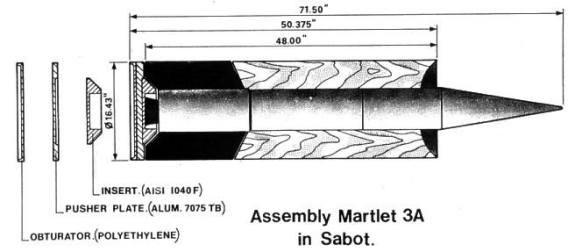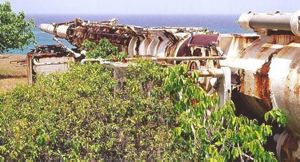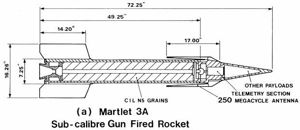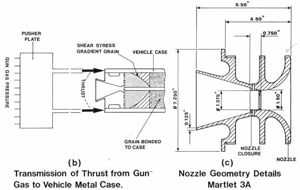
Home - Search - Browse - Alphabetic Index: 0- 1- 2- 3- 4- 5- 6- 7- 8- 9
A- B- C- D- E- F- G- H- I- J- K- L- M- N- O- P- Q- R- S- T- U- V- W- X- Y- Z
Martlet 3A

Martlet-3A Sabot
Martlet 3A in its sabot. Martlet 3B was similar.
The theoretical performance of the Martlet 3A was for an 18 kg payload to be carried to an altitude of some 500 km at gun-launch accelerations of 12-14,000 g's and gun launch velocities in the range of 2100 m/sec (similar to the Martlet 2 series maximum launch parameters).
Status: Retired 1964. First Launch: 1963-09-05. Last Launch: 1964-01-15. Number: 11 . Payload: 18 kg (39 lb). Gross mass: 180 kg (390 lb). Height: 1.83 m (6.00 ft). Diameter: 0.18 m (0.59 ft). Apogee: 500 km (310 mi).
Martlet 3 Series - General
The HARP Project's Martlet 3 series of gun-launched vehicles were all single-stage, gun-boosted rockets. This series began as an attempt to extend the peak altitude of a gun-launched high altitude probe by adding a rocket stage to a vehicle of the same mass as the Martlet 2.
The HARP Project engineers recognized early in the program that if they designed a new vehicle which included a high mass-fraction rocket for second stage boost, but with the same launch mass and velocity as the Martlet 2, the added boost from the rocket motor would provide a significant increase in both altitude and payload. It was also recognized that this would be the first step towards the development of the multi-stage Martlet 4 series - a gun-launched satellite vehicle.
The development of gun-launched rockets during the HARP Project began at a time when rocketry itself was still in its infancy. It was not at all uncommon in the early sixties for new rocket designs to fail during test flights. To complicate matters there was practically nothing previously known about the dynamics of solid rocket motors during the accelerations and stresses of gun launching.
The only serious attempt to develop a gun-launched rocket prior to HARP was during World War 2 when the first Rocket-Assisted Projectile (RAP) was produced. The RAP used a very small rocket motor which added only a few hundred feet per second to the shell's velocity. This small velocity increase was of little interest to HARP.
The development of gun-launched rockets during HARP began by exploring the most fundamental technical aspects of the designs. The rapid pace of the of development of the various Martlet 3 vehicles is a credit to the ingenuity of the HARP staff, particularly considering the financial constraints imposed by the limited funding. The Martlet 3A and 3B vehicles were a remarkably successful test bed. A wide variety of techniques were tested in a relatively short time.
Perhaps the most important development stemming from the Martlet 3A and 3B vehicles was the hydrostatic containment technique used to prevent the rocket motor grain from deforming during gun launching.
During the early Martlet 3A test flights it was found that an unsupported, case bonded, core burning, rocket motor grain would mechanically fail at gun launch loads of about 5000-6000 g's, which was only half of the desired gun launch loading for an ideal vehicle configuration. During this failure the rocker motor grain would first deform and then extrude into the central cavity and out of the rocket nozzle. This would render the motor effectively useless as a propulsion stage and had to be addressed if any serious uses of Gun-launched Rockets were to be realized .
The obvious solution was to switch from a core burner to a solid end burner rocket motor. End burners were successfully tested and it was found that they could withstand full gun launching loads (12,000 + g's). Unfortunately end burners have an undesirable performance for the HARP application, including a lower thrust and a longer burn time, and they had to be abandoned.
After considerable effort it was found that by filling the central cavity with a fluid of equal density to the rocket fuel grain, and then plugging the rocket nozzle, the rocket motors could be launched at the desired loads. By filling the core of the rocket motor with fluid, the fluid and the rocket grain would perform as a single mass of unified density under load and the fuel grain would not deform. This technique would become HARP's primary method of supporting rocket motors during gun launching.
By mid-1964 the focus of gun-launched rocket motor development had shifted from sub-caliber rockets to the Martlet-3E and Martlet-3D full-bore rockets. The development of full-bore rockets, as with the sub-caliber rockets, began with the most basic fundamentals and progressed rapidly to operational vehicles.
The basic design developed for all HARP full-bore rocket vehicles consisted of a Fiberglas bore-riding airframe with flip-out fins for aerodynamic stability and a propellant mass fraction of 0.80.
Full-bore rockets were developed for two gun systems during HARP. The rocket vehicles developed for the portable 7 inch HARP guns were primarily intended to serve as high altitude atmospheric sounding probes similar to the Martlet 2. The full bore rockets developed for the 16 inch gun system were intended to be part of the Martlet-4 gun-launched satellite vehicle.
Martlet 3A
The Martlet 3A was the first serious attempt to produce a sub-caliber, gun-launched, rocket-assisted, vehicle for the 16 inch gun system. The basic design criteria for the Martlet 3A was to gun launch a vehicle containing a rocket motor that could provide a velocity boost equal to or greater then the initial gun-launch velocity.
The theoretical performance of the Martlet 3A was for an 18 kg payload to be carried to an altitude of some 500 km at gun-launch accelerations of 12-14,000 g's and gun launch velocities in the range of 2100 m/sec (similar to the Martlet 2 series maximum launch parameters).
After launch the rocket motor ignition was delayed 14 seconds while the vehicle coasted in ballistic flight, as the Martlet 2, before the rocket stage was ignited. During development this allowed the vehicle's structural and launch problems to be separated from rocket ignition and flight problems.
The Martlet 3A was similar in appearance to the Martlet 2 series. The Martlet 3A rocket motor used a standard 6 inch (15 cm) diameter by 40 inch (1.0 m) long double-base, cast-propellant, core-burning rocket motor grain. The rocket fuel grain was case bonded to the heavy aluminum motor case with a 7 inch (18 cm) exterior diameter. The overall length of the vehicle was 72 inches (1.83 m) with a straight taper nose cone and four simple fins for stability.
The Martlet 3A employed a pusher-plate and petal-arm sabot similar to that of the Martlet 2 series. The notable difference was the use of a steel load-spreading disk that transferred the launch loads to the rim of the motor case rather than the entire base of the vehicle. It was intended that the launch loads would be transferred from the pusher plate to the vehicle's airframe and then to the rocket motor fuel grain through the case bonding. There was limited support provided at the base of the motor by the nozzle assembly.
The Martlet 3A design program began in the spring of 1963 with test flights beginning in September. Early Martlet 3A test flights were less then successful. At launch loads of 5000-6000 g's the rocket motor fuel grain would fail as described previously.
The Martlet 3A set a world record as the largest rocket launched from a gun.
by Richard K Graf
Payload: 18 kg (39 lb) to a 500 km altitude (planned).
Family: Gun-launched. Country: Canada. Launch Sites: Barbados HARP gun 16 inch. Agency: Bull.
 | Project HARP 16 inch Used with permission of Stephen E. Mendes - visit his Barbados Photo Gallery Credit: © Stephen E. Mendes |
 | Martlet-3A Drawing |
 | Martlet 3A detail |
 | Project HARP 16 inch Used with permission of Stephen E. Mendes - visit his Barbados Photo Gallery Credit: © Stephen E. Mendes |
1963 September 5 - . Launch Site: Barbados Site. Launch Complex: Barbados HARP gun 16 inch. LV Family: Martlet. Launch Vehicle: Martlet 3A.
1963 September 5 - . Launch Site: Barbados Site. Launch Complex: Barbados HARP gun 16 inch. LV Family: Martlet. Launch Vehicle: Martlet 3A.
- Test mission - .
Nation: Canada.
Agency: HARP.
Apogee: 100 km (60 mi).
The Martlet 3A gun-launched rocket program began in the spring of 1963 with test flights beginning in September. Early Martlet 3A test flights were less then successful. At launch loads of 5000-6000 g's the rocket motor fuel grain would fail.The Martlet 3A set a world record as the largest rocket launched from a gun.
1963 September 5 - . Launch Site: Barbados Site. Launch Complex: Barbados HARP gun 16 inch. LV Family: Martlet. Launch Vehicle: Martlet 3A.
1963 September 5 - . Launch Site: Barbados Site. Launch Complex: Barbados HARP gun 16 inch. LV Family: Martlet. Launch Vehicle: Martlet 3A.
1964 Jan - . Launch Site: Barbados Site. Launch Complex: Barbados HARP gun 16 inch. LV Family: Martlet. Launch Vehicle: Martlet 3A.
1964 Jan - . Launch Site: Barbados Site. Launch Complex: Barbados HARP gun 16 inch. LV Family: Martlet. Launch Vehicle: Martlet 3A.
1964 Jan - . Launch Site: Barbados Site. Launch Complex: Barbados HARP gun 16 inch. LV Family: Martlet. Launch Vehicle: Martlet 3A.
1964 Jan - . Launch Site: Barbados Site. Launch Complex: Barbados HARP gun 16 inch. LV Family: Martlet. Launch Vehicle: Martlet 3A.
1964 Jan - . Launch Site: Barbados Site. Launch Complex: Barbados HARP gun 16 inch. LV Family: Martlet. Launch Vehicle: Martlet 3A.
1964 Jan - . Launch Site: Barbados Site. Launch Complex: Barbados HARP gun 16 inch. LV Family: Martlet. Launch Vehicle: Martlet 3A.
1964 January 15 - . Launch Site: Barbados Site. Launch Complex: Barbados HARP gun 16 inch. LV Family: Martlet. Launch Vehicle: Martlet 3A.
Back to top of page
Home - Search - Browse - Alphabetic Index: 0- 1- 2- 3- 4- 5- 6- 7- 8- 9
A- B- C- D- E- F- G- H- I- J- K- L- M- N- O- P- Q- R- S- T- U- V- W- X- Y- Z
© 1997-2019 Mark Wade - Contact
© / Conditions for Use